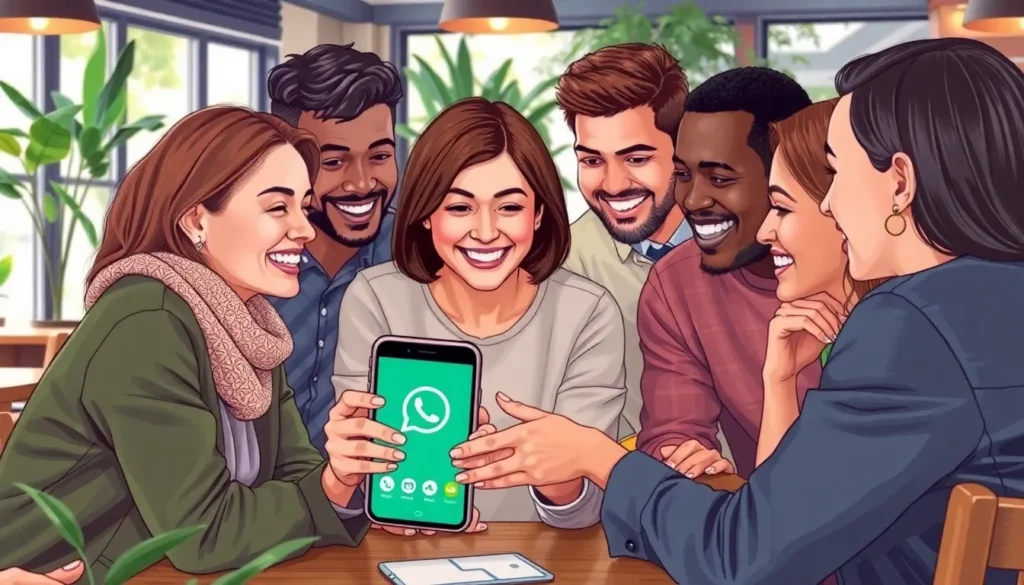Table of Contents
ToggleIn a world where staying connected is as crucial as breathing, WhatsApp burst onto the scene like a superhero in a spandex suit. Launched in January 2009, this messaging app transformed the way people communicate, turning mundane text exchanges into lively conversations. Who knew a simple green icon would become the lifeline for millions, helping friends share cat memes and family updates in real-time?
Overview of WhatsApp
WhatsApp launched in January 2009, quickly gaining traction among users worldwide. The app’s primary focus remains on instant messaging, allowing individuals to communicate effortlessly. Over time, WhatsApp introduced features like voice calls, video calls, and file sharing, enhancing user experience significantly.
With over 2 billion active users by 2021, WhatsApp stands as one of the most popular messaging platforms globally. Users appreciate the app for its end-to-end encryption, which secures conversations from unauthorized access. Businesses also leverage WhatsApp for customer engagement, showcasing products and providing support through the platform.
The app’s user-friendly interface simplifies navigation, making it accessible for all age groups. Multimedia sharing offers a variety of options, including photos, videos, and audio messages. Notifications keep users informed about incoming messages or calls, ensuring they stay connected.
WhatsApp Web, introduced in 2015, allows users to access their accounts on desktop computers. This feature increases convenience, enabling users to type messages on a full keyboard. Continuous updates adapt the app to changing user preferences and technological advancements, maintaining its relevance in the evolving digital landscape.
Since its acquisition by Facebook in 2014, WhatsApp introduced additional business-focused features, including catalog sharing and automated replies. These developments symbolize the platform’s evolution from a simple messaging app to an essential communication tool for individuals and businesses alike.
The Launch of WhatsApp

WhatsApp made its debut in January 2009, revolutionizing the way people communicate. Within a short period, it transformed texting into lively conversations that connected individuals around the globe.
Founders and Creation
Brian Acton and Jan Koum, former Yahoo employees, founded WhatsApp to address a void in the messaging landscape. Their vision aimed at creating a user-friendly app that facilitated seamless communication. Acton and Koum’s background in engineering and technology provided a solid foundation for the app’s development. The pair focused on building a product that emphasized privacy and flexibility, ensuring it met user demands. Inspired by their experiences, the duo poured their hearts into creating a platform that resonated with millions.
Initial Features at Launch
WhatsApp launched with several key features that set it apart from competitors. Users could send text messages instantly while enjoying a clean and intuitive interface. The app emphasized simplicity, ensuring users felt comfortable navigating its functions. Initially, voice calls and multimedia sharing options were not available, but instant messaging was its core feature. Notifications kept users informed about new messages, enhancing engagement. The absence of ads further contributed to a clutter-free experience, aligning with the founders’ vision of user satisfaction. Features introduced at launch laid the groundwork for future enhancements, leading to its rapid popularity.
Evolution of WhatsApp Over the Years
WhatsApp has undergone significant changes since its inception in January 2009, continually enhancing user experience and functionality.
Major Updates and Changes
The application introduced voice calling in 2015, revolutionizing communication beyond text. In 2016, video calling became available, allowing users to connect face-to-face. The addition of multimedia sharing features enabled users to send photos, videos, and audio messages effortlessly. Furthermore, a business version launched in 2018, catering specifically to enterprises and customer interactions. End-to-end encryption secured users’ privacy and communicated WhatsApp’s commitment to protection. Features like status updates and group video calls further boosted its appeal, making communication versatile. Continuous integration of new functionalities keeps WhatsApp relevant and engaging for its more than 2 billion users worldwide.
Expansion to Global Markets
WhatsApp quickly became a dominant messaging platform across various countries. Its user-friendly interface attracted people from different age groups and backgrounds. The app’s compatibility with low-bandwidth connections contributed to its success in emerging markets. In regions like India and Brazil, WhatsApp became the primary means of communication. The localization of languages also played a crucial role in its widespread adoption. As businesses recognized the platform’s potential, customer service through WhatsApp gained traction. In 2021, WhatsApp launched features for businesses to facilitate product catalogs and automated replies, marking its presence in e-commerce. Global expansion continues to shape its evolution in the competitive messaging landscape.
Impact of WhatsApp on Communication
WhatsApp transformed global communication patterns significantly since its launch in January 2009. Instant messaging evolved, shifting from basic text exchanges to immersive conversations enriched with multimedia. Millions rely on WhatsApp daily to share everything from cat memes to important family updates. Various features like voice calls and video calls added depth to messaging, enhancing users’ ability to connect in real-time.
With over 2 billion active users in 2021, the platform ranks among the world’s most popular messaging applications. Users appreciate the app for its commitment to privacy, evident through its end-to-end encryption that secures conversations across devices. Businesses also recognize WhatsApp’s potential, utilizing it for customer engagement and real-time support.
The user-friendly interface caters to all age groups, making technology accessible. Various multimedia options allow sharing photos, videos, and audio messages seamlessly. Notifications ensure users are always informed about updates and incoming messages, fostering continuous connectivity. Introduced in 2015, WhatsApp Web allowed for desktop access, enhancing convenience further.
Recent updates reflect the evolving digital landscape, adapting to user preferences effectively. Since Facebook’s acquisition in 2014, WhatsApp has expanded features significantly. New functionalities, such as catalog sharing and automated replies, transformed it into a vital communication tool.
Founders Brian Acton and Jan Koum aimed for simplicity and privacy, shaping WhatsApp’s core philosophy. Initial features focused on instant text messaging while avoiding ads, creating a clutter-free user experience. Notable updates continued to enhance the app’s offerings, including voice and video calling capabilities introduced in 2015 and 2016, respectively.
WhatsApp’s expansion, particularly in markets like India and Brazil, solidified its dominance in the messaging realm. Compatibility with low-bandwidth connections and localization efforts further supported its widespread adoption. Continuous innovation keeps WhatsApp relevant, engaging millions of users worldwide effectively.
WhatsApp’s journey since its launch in January 2009 has been nothing short of remarkable. It has transformed how people communicate across the globe. With its focus on user privacy and innovative features, the app has successfully maintained its relevance in a fast-paced digital world.
As it continues to evolve, WhatsApp remains a critical tool for both personal and business communication. Its ability to adapt to user needs ensures that it will likely stay at the forefront of messaging apps for years to come. The impact of WhatsApp on global communication is undeniable, making it an essential part of everyday life for billions.







